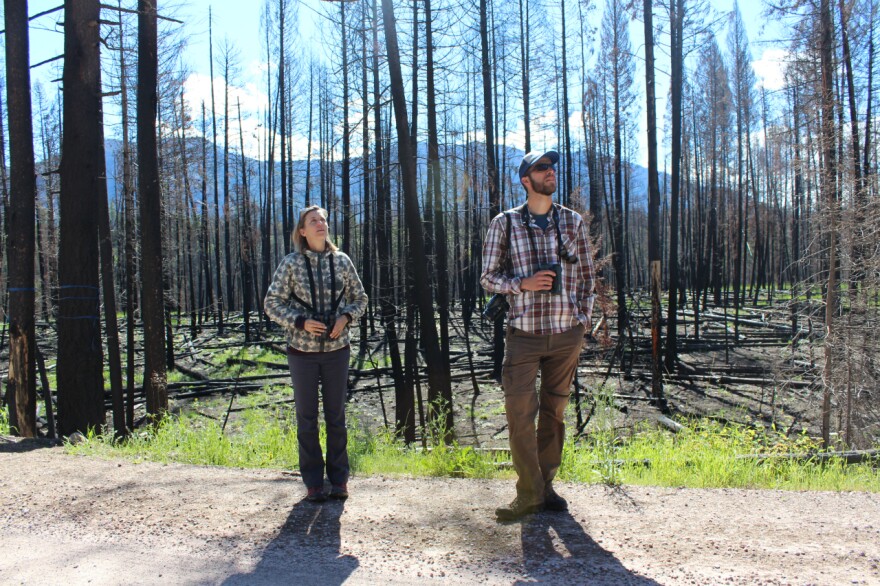Salvage logging on a portion of the Rice Ridge Fire burn area near Seeley Lake is set to begin soon. The U.S. Forest Service is finalizing plans to log about 5,600 acres on the 160,000 acres that burned in the biggest wildfire Montana saw last summer.
I recently visited the salvage logging site, about half a mile drive outside Seeley Lake, with Megan Fylling and Willaim Blake. They’re avian biologists, Fylling is with the University of Montana Bird Ecology Lab and Blake at MPG Ranch.
In this patch of the Rice Ridge burn, morel mushrooms hide under fallen logs. Bright pink fireweed attracts nectar-eating bats and butterflies. Elk, deer, and bears will wander through the skeletal trees to forage. And secondary cavity nesters like mountain bluebirds and flycatchers arrive to take over tree holes made by other birds, like the black-backed woodpecker.
It doesn't take Fylling long to spot a pair - a male feeding a fledgling.
“Oh yeah, there’s a nest," she says to Blake. “Oh my gosh, I can’t believe we found one so fast."

The birds have white stomachs and completely black backs that blend in with the trees. Males have bright yellow heads.
Last summer’s fire created new habitat for black backed woodpeckers, which are rarely found outside of burned forests. They come feed on insect larvae that live in the weakened, burned trees. They’ll only stay in an area for three to five years before moving to a newly burned forest with a refreshed food source.
Fylling sees real potential for this landscape. It’s easily accessible and shows how life comes back after a fire, and sometimes depends on fire.
“There’s a huge ecological benefit," she says. "There could potentially be a huge education component and a huge ecotourism benefit to the community surrounding as well, for people to come up here and see the forest and the process that’s taken place in this disturbed ecosystem, and find the special animals that live here, like the black-backed woodpecker.”
Fylling would prefer for there to be no logging here. She says not much is known about the woodpeckers’ dispersal or population numbers. And the Forest Service considers them to be a sensitive species.
But Steve Brown with the Lolo National Forest says the salvage logging project being proposed here won’t have a big impact on woodpeckers or other wildlife.
“When you look at the scope and scale of what it is we’re proposing, it’s really fairly minimal," Brown says.
The Forest Service is in the process of choosing a middle ground between two proposed plans: Both include removing hazard trees along roads and reforesting parts of the burn. One proposes salvage on 2,700 acres and does not add any temporary roads. The other proposes 5,600 acres of salvage and does add temporary roads. Brown says they’re aiming to have a decision ready by the end of this month.
He says the salvage provides economic opportunity in the area. And the faster logging starts, the better.
“The sooner we give industry a chance to get in and start harvesting them, the more likely they’ll actually be able to make money on it," Brown says.
The Forest Service’s Environmental Assessment says burned trees lose an average of about 15 percent of their value in the first year, and 30 percent or more the second year.
So, Brown says, salvage logging can’t wait wait a couple of years for black-backed woodpeckers to have some undisturbed breeding seasons, or move to a new area.
He acknowledges that logging will reduce the birds’ foraging habitat, and trees marked to be cut could have nests in them.
At most, Brown says, the number of black-backed woodpecker nests would be reduced by 16, from 332 nests to 316. Enough black-backed woodpeckers would remain to maintain a viable population. He also says the woodpeckers can live in surrounding burned areas, like in the Bob Marshall Wilderness, that can’t be logged.
“Would it have an effect on certain woodpeckers? Yes it would," Brown says. "Would it affect woodpeckers as a species? No it would not.”

The area is also home to sensitive species like fishers, flammulated owls, cutthroat trout, and whitebark pine that could be impacted by logging.
There are also threatened species like grizzly bears, bull trout and Canada lynx. Brown says they accounted for these species in the proposed plans.
“Rice Ridge is a very special area in terms of wildlife habitat," Brown says, "and so, like I said, our design criteria were all meant to mitigate any sort of effect on those species.”
Roads won’t be added to areas previously identified as grizzly habitat. Logging won’t take place in lynx habitat. And some roads will be rerouted to keep sediments out of streams to protect bull trout.
They also won’t log along riparian conservation zones or in old growth areas.
Right now, the Forest Service is finalizing their decision for the project. They’re looking at what has changed in the past year, and at public comments to see what they might have missed in the plan proposals. Once the plan is finalized, Brown says they’ll start logging as quickly as possible to prevent more economic loss from the deteriorating trees.
Brown says whatever action they take will have an impact on the species that live in the burn, but they’re trying to make it as minimal as possible.
Back on the burn area, University of Montana Avian Biologist Megan Fylling says she understands why people want to log the area, but believes it’s too valuable to do so, both for its educational opportunities and for the habitat it provides.
“We’re fortunate to have a lot of wilderness areas and national parks where things aren’t getting salvage logged," Fylling says, "but in no way, shape, or form does that compensate for the entire landscape that we’re standing in and that we’re responsible to maintain.”


